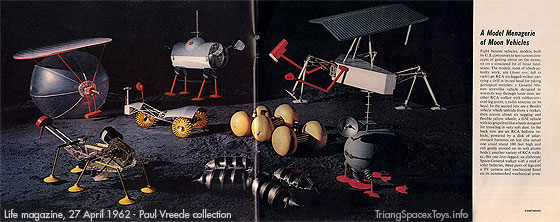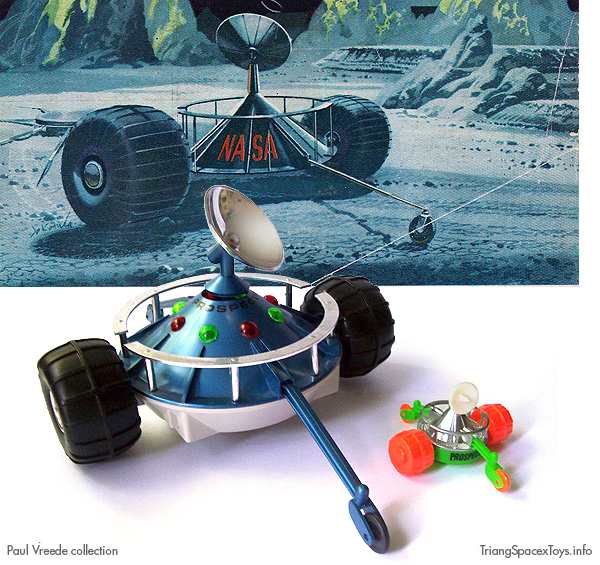
Before President John F Kennedy made his famous plea for "sending a man to the Moon before the decade is out" in May 1961 (1), NASA had been planning to start exploring the Earth's sattellite by unmanned means. Even though the Mercury programme was in full development and astronauts were being trained to fly the first missions, manned space flight was deemed to take a lot of development before going any serious distance. As was reported in an article in Flight magazine in December 1960 (2), unmanned exploration was very much the way forward to learn about other planets.
To explore the Moon, a trio of spacecraft were being developed: Ranger, to take many detailed pictures and measure tremor intensity while crashing into the Lunar surface; Surveyor, to land and take pictures and soil samples; and Prospector, a remote-controlled mobile laboratory developed by General Electric's Missile and Space Vehicle Dept that would land on the Moon to do mapping surveys and take further samples.
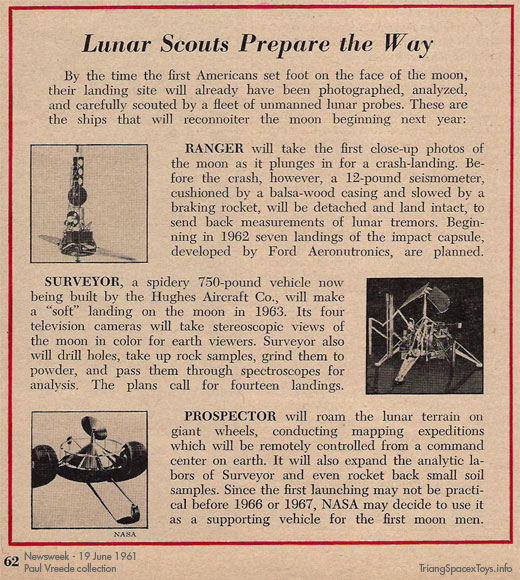
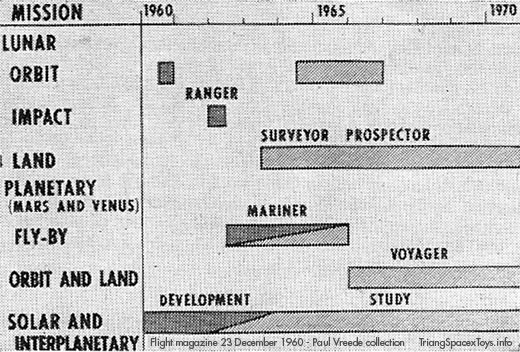
As is shown by the NASA programme chart above, unmanned Moon missions would have lasted into the 1970s at least. But then a momentous thing happened. On 12 April 1961, the world was greatly surprised when Yuri Gagarin became the first human in space, orbiting the Earth in Vostok 1. As a hurried response, NASA sent up Alan Shepard to make a suborbital flight in the Freedom 7 Mercury craft on May 5th. But it was President Kennedy who really took up the gauntlet in his speech later that month, and NASA made good on the President's words when Man reached the Moon 8 years later.
The shift in emphasis towards manned spaceflight produced a casualty, and that was the Prospector project (funding eventually being cancelled by the US Congress in 1962). Even if it still made the cover of Newsweek in June 1961, the story inside was all about manned Apollo missions, with the unmanned spacecraft relegated to the little sidebar shown above. Prospector might now have helped the astronauts on the Moon, but this never happened.(3) Except later, when all had been turned into toys.
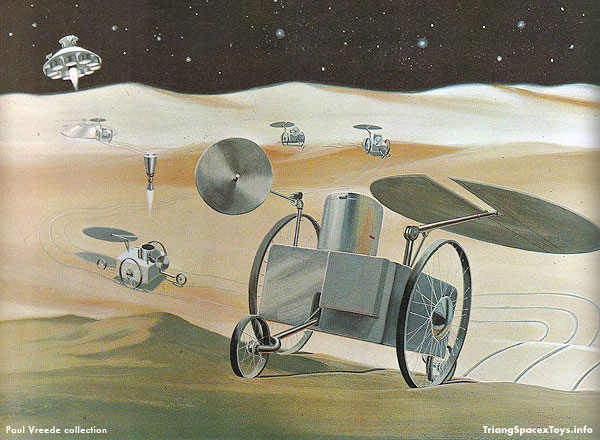
Early ideas illustrated by Roy Scarfo with two, four or six wheels (the four-wheeler shown on
the delivery vehicle below), which would launch a small rocket with samples back to Earth.
There was also a manned version which looks most rudimentary!
Since these illustrations also appear in a Prospector project description (undated) from
General Electric, we can assume that's what they were created for.
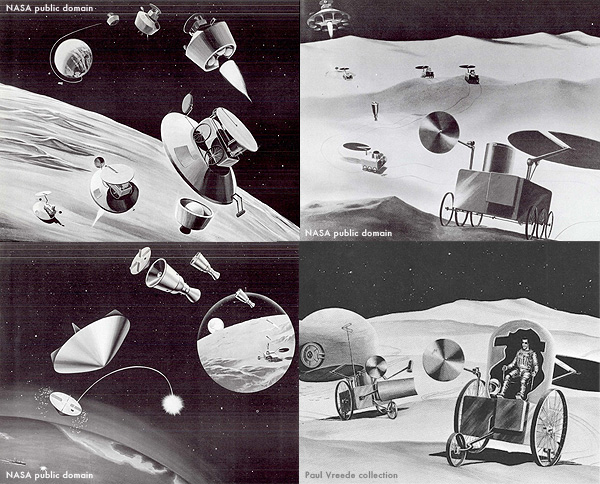

By January 1960 (date on illustration at right) the moon rover had evolved somewhat.
At right it is also shown sitting sideways in/on the delivery vehicle.
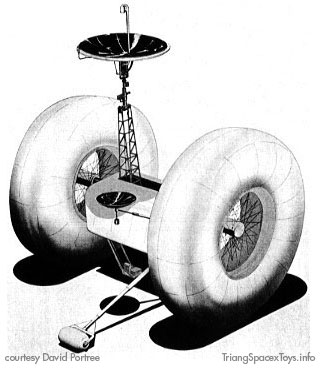

This 'stationary packet' could rotate on its base, but otherwise is
starting to look like 'our' Prospector.
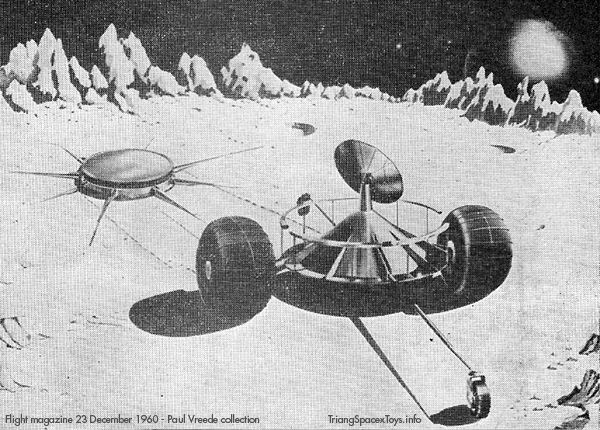
NASA had published artist's renderings like the ones above, with the last one showing Prospector as we know it starting out on the lunar surface. It would just have deployed its dish, inflated its balloon tyres, extended its stabilising telescopic arms at front and rear and would now be piloted on its way by remote control from Earth.
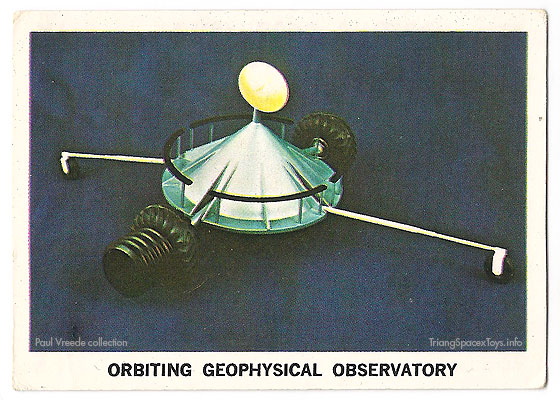
GE (presumably) also made a nice model of the final design, here shown on a
Space-Pak collecting card from 1962 (where there was a mix-up because the name and text on the card back are for an entirely different spacecraft).
The ribbed piece attached to one wheel apparently served to place the model on its side for a top-view photograph.
The Newsweek cover illustration (by artist Jo Kotula) is clearly based on NASA concept art, also showing a Surveyor coming in for a landing at left and a Voyager (actually slated for Mars and Venus missions) orbiting at right.
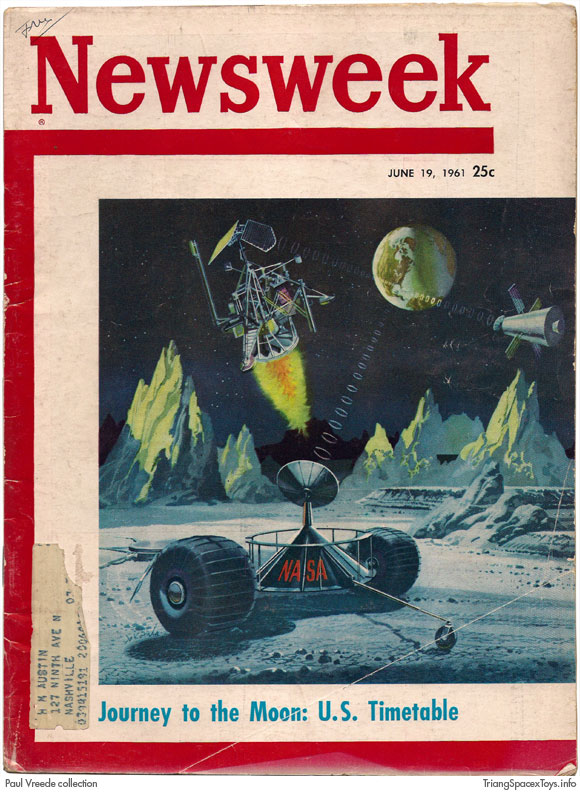
It may have been the Newsweek cover that inspired Hong Kong toy manufacturer Tai Hing to think the Prospector would make a good toy. Prospector's metal body is shown in blueish shadows on the cover illustration, and this may account for the toy having a blue body.
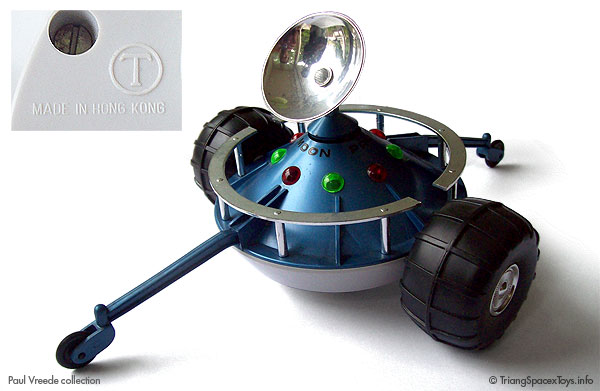
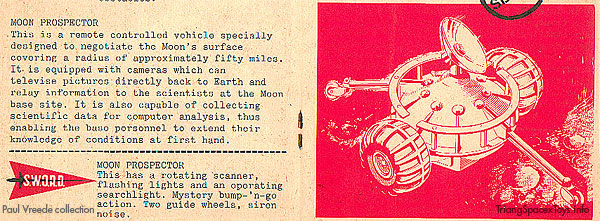
The Tai Hing Prospector is a lovely toy, measuring 33cm/13" long, 22.5cm/9" wide and 14.5cm/5 3/4" high, battery operated with bump'n'go action (making it reverse and turn when meeting an obstacle), flashing lights on its dome and a rotating dish antenna, and carrying the Tai Hing T-in-a-circle trademark underneath. Little wonder that Jack Rosenthal decided to bring it to Britain as one of the toys that would constitute the Project Sword fleet, now marked with the Century 21 trademark. Within the associated storyline, Prospector would do in fiction what it was intended to do in reality: explore the Moon and collect samples and data. Next to the Project Sword manual shown above (actually a catalogue included with the toys), it was also featured in the Project Sword annual (below - click on image for a readable version in a new window, but bear in mind the descriptions for the vehicle are mostly fictional :)
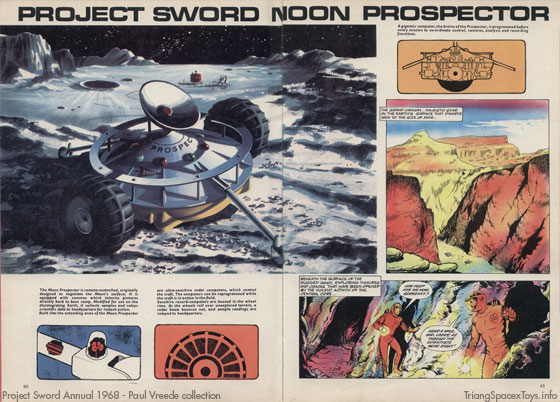
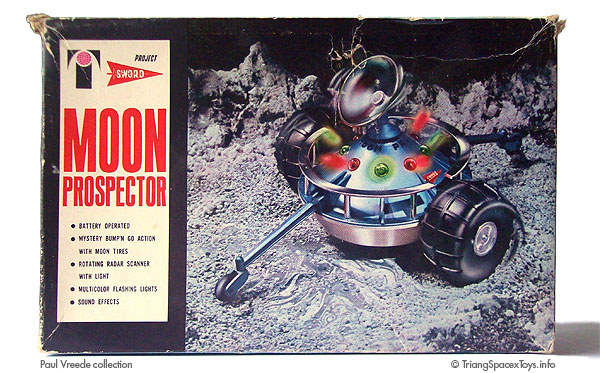
After Project Sword was marketed by Century 21 Toys in the UK, the range was also made available in the US by Tarheel Industries of Tarboro, North Carolina. My Prospector is one of these, though the only difference is in the box (above) and mine having the original Tai Hing T-in-a-circle trademark again; they're otherwise identical.
After Jack Rosenthal also included the Prospector when he set up the Spacex range for Triang, it got another cousin in the Anderson universe when Japanese kit maker Imai included a tiny Prospector in its UFO Moon Base kit, moulded in pale blue. Mike Burrows built a recent reissue of this kit by Aoshima, and painted up the little Prospector to look like the Sword toy.
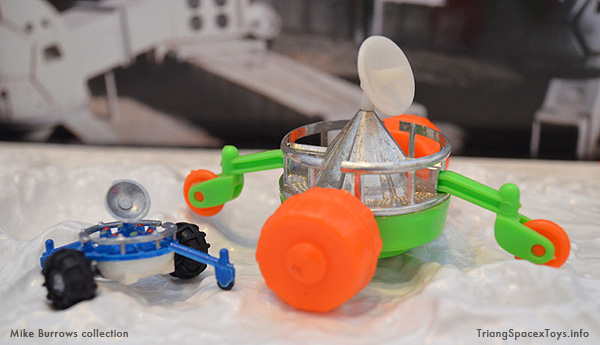
External links open in new pages. Just close them to get back here.
1: JFK in a speech to a joint session of Congress, 25 May 1961. You can read his speech and see him delivering it at the Miller Center website of the University of Virginia. The part about space is at section IX in the text, and at 30 minutes into the speech (you can forward the video clip once it has loaded that far). If you just want to see JFK speak that one phrase, try YouTube. back to text
2: You can read the article on the Flight International archive site (the second page is the next in the list of thumbnails. Do note these are pdf files which your browser may download instead, depending on your set-up). back to text
3: Although the Prospector programme was cancelled, NASA's contractors continued tests of other developments for a SLRV (Surveyor Lunar Rover Vehicle) - a rover to be deposited by the Surveyor lander. When that programme was eventually also curtailed, the final contenders were a six-wheeled design by General Motors and a vehicle on caterpillar tracks by Bendix (the latter looking like it could have been Wall-E's granddad :) More on GM's rover vehicles can be found over at Dean's Garage. back to text
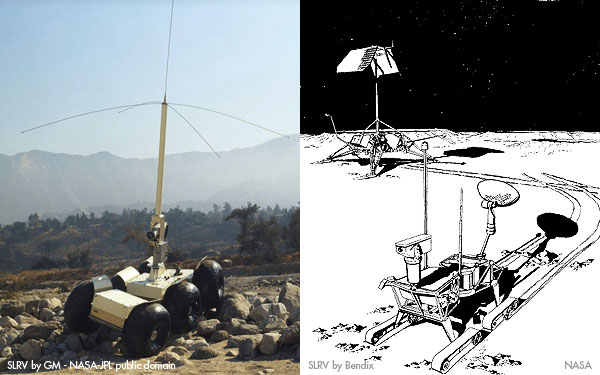
I don't want to close this subject without showing (below) some of the other weird and wonderful contraptions under consideration, from an article in Life magazine from 1962 (click for a readable version in a new window). The walker in the middle at the back was turned into a very nice toy by Yonezawa (see at end of this description on the excellent Cyberneticzoo - now sadly defunct but saved in the priceless Internet Archive). The two vehicles sitting across the fold can be seen being tested by General Motors on Youtube, starting at about halfway through the clip. back to text
